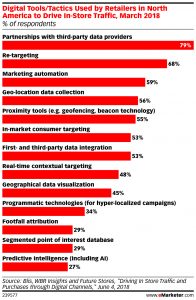Strategically, driving in-store sales using digital marketing requires a mixture of direct response messaging, geotargeting, and geofencing alongside carefully developed audiences.
_
Every brand hopes for a magic bullet.
For some marketers, the magic bullet looks like a billboard. Some think it’s a T.V. ad.
For others, it’s being able to justify their spending on ad campaigns they can’t quite measure.
For the longest time, tracking marketing and sales across the digital divide to in-store traffic has been a sticking point, especially for brick and mortar retailers looking to drive sales through digital marketing.
And a couple of years ago, Google created a new metric for tracking users further down the funnel from digital interactions to in-store sales. With their new Google Store Visits (GSV) metric, Google found that two in five people who clicked on the ad later visited the store.
Two in five.
These users spent about three times more in-store than they had online.
More and more health retailers have gotten savvy about using digital tech to track in-store sales. In fact, there are a number of tactics being deployed.
And it makes sense – more and more people are in-store shopping with their smartphone in-hand. According to 2014 data, that number was around 60% in younger users.
So how can your health brand use digital marketing to generate sales in-store?
How Good Marketing Tactics Help To Get Customers.
First of all, digital technology isn’t a magic bullet.
Being able to track users by location down to the millimeter is worthless without good marketing – a winning marketing strategy starts with a strong brand and a persuasive offer that pushes users to act and become your customers.
Once you’ve figured out what customers want and what inspires them to take action, you’re ready to wage marketing in a meaningful way.
You’ve got a robust ecology of digital options at your fingertips with paid search advertising. And it will be getting through paid social media, native advertising, and programmatic display.
How and when to deploy each of these tactics is the big question.
The answer lies in tracking & measurement to see the response rates at different points in the customer journey. Measuring well, even if not perfect, can show you which digital tactics are working to drive in-store sales.
Using online to build a database of health consumers, gives you even more leverage in supporting your health brand at retail.
You’re going to need the power of analytics to accurately measure the sales cycle. It is due to get a clear picture of how you should structure your marketing to produce the optimal result. And better customers at the best possible cost per acquisition.
Measurement is the foundation of direct marketing. Without measurement, marketing is mere conjecture – not the science that it has evolved to become.
So, my question for you is – what are you measuring?

